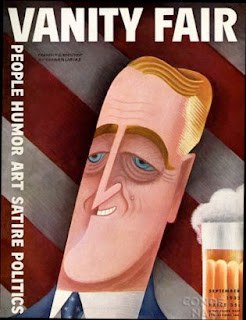 |
| Lucky Luciano - acrylic on canvas - 24" x 40" |
If there ever was a “genius” at crime, it was found in Salvatore Lucania, better known as “Lucky” Luciano.
Born in Sicily, Italy in 1897, Salvatore came to the U.S. with his family in 1906. He struggled in school, finally dropping out. But before he left, Salvatore had already started his own racket: selling protection to classmates with the threat of giving them a beating if they didn’t pay.
He made lifetime friends and partners in crime Meyer Lansky and Benjamin “Bugsy” Siegel during his teenage years, and served six months in a reformatory for selling heroin at the age of 19. Throughout the 1920s, Luciano was one of the “Big Six” in New York who made large amounts of money bootlegging throughout the prohibition era.
In 1929, Salvatore became “Lucky” when he survived a savage beating and stabbing ordered by crime boss Guiseppi Masseria. Not to let bygones be bygones, Lucky got even in 1931 when he helped arrange Masseria’s grisly murder, soon taking over the “boss’s” spot as one of the top leaders of one of New York City’s five families.
During the early 1930s Luciano demonstrated his talents, focusing on improved ways for criminal gangs to do business. His objective was create a national organized crime network to quell conflicts and manage disputes between different operations.
Lucky enjoyed the high life with lots of cash, living quarters at the Waldorf Astoria Towers, hand made suits and chauffer-driven cars until his “luck” ran out when special prosecutor Thomas E. Dewy was appointed to look into organized crime. In 1936, Luciano and eight members of his vice racket were brought to trial, convicted on extortion and prostitution charges, and sentenced to 30 to 50 years in jail.
With the help of his friends on the outside, Lucky didn’t exactly languish in prison. He ate well, had his clothes professionally cleaned, ran his business, and awaited any chance for release that he could find.
In 1942, the U.S. Office of Naval Intelligence was concerned about German and Italian agents entering the United States through the New York waterfront. They also worried about sabotage of ships and warehouses on the docks. Knowing that the Cosa Nostra controlled the waterfront, the Navy contacted Meyer Lansky about a deal with Luciano. To facilitate negotiations, the State of New York transferred Luciano from Clinton prison to Great Meadow Correctional Facility, a minimum security prison, which was also much closer to New York City.
It was claimed that Luciano promised the complete assistance of his organization in providing intelligence to the Navy and helped protect the docks through his relationship with ally Albert Anastasia who controlled the New York waterfront. Though in later years, Lucky denied that he provided help to the Navy, he was released from prison under the condition that he return to Italy and never enter the United States again.
In October, 1946, Luciano secretly moved to Cuba to be closer to the U.S. so he could resume control over the American Cosa Nostra, but was expelled from Havana early in 1947 returning to Naples where he remained for the rest of his life.
Though a murderer and a known heroin smuggler, Luciano was loved by the many and respected for being a gentleman who helped those in need. 300 people attended his funeral in Naples and his body was returned to New York for burial in St. John’s Cemetary in Queens where 2000 Americans mourned his passing.



















